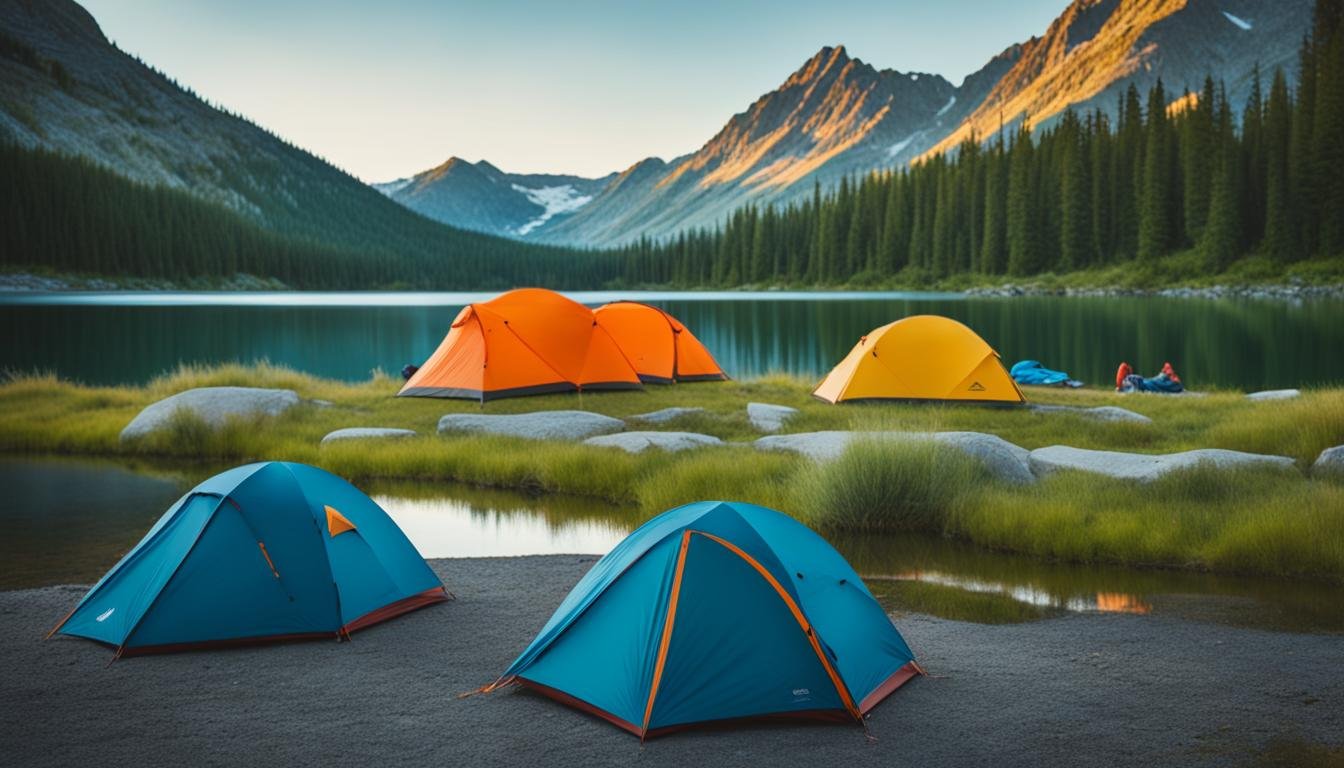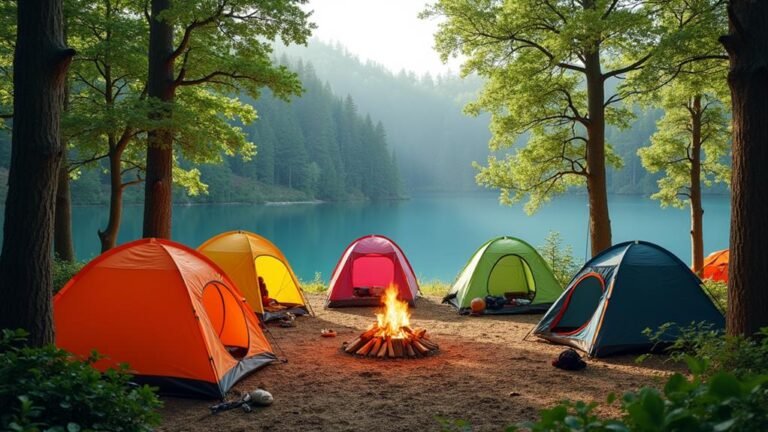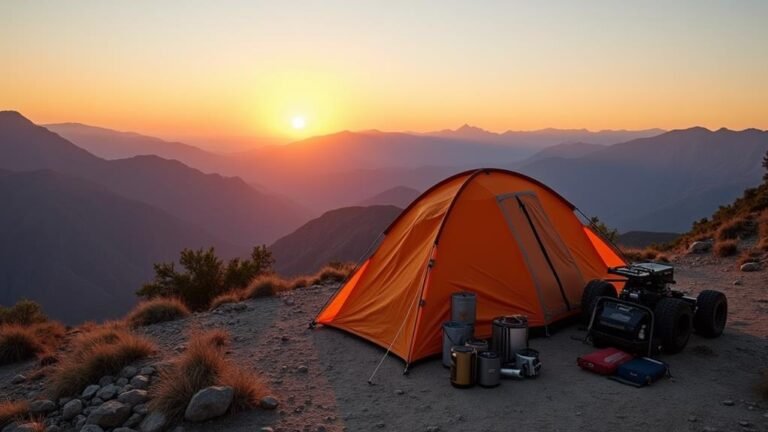Did you know that some ultralight tents weigh as little as 20.96 oz,1 including the tent, fly, and stakes? This super light design is a game-changer for hikers and campers. It offers easy setup, keeps you dry, and packs small. These are perfect for anyone hiking, backpacking, or just getting outdoors.
Key Takeaways
- Ultralight tents can weigh as little as 1 lb. 2 oz. to 3 lb. 5 oz., offering a significant weight reduction compared to traditional backpacking tents.2
- Leading lightweight tent models feature spacious floor plans, with dimensions ranging from 84 x 48/42 inches to 107 x 83 inches, accommodating 1 to 4 people.3
- Prices for top-rated ultralight tents span a wide range, from budget-friendly options at $188 to premium picks costing up to $1,100.3
- Durable, weather-resistant materials like Dyneema Composite Fabric (DCF) and 20D sil-nylon provide reliable protection in diverse outdoor conditions.1
- Versatile setup options, including trekking pole designs and freestanding structures, offer flexibility to suit various camping needs.1
Introduction to Lightweight Tents
Lightweight tents are all about shedding extra weight without losing protection. They reduce what you need to carry without compromising on shelter. This makes them perfect for anyone wanting to go light while camping.
Benefits include a lighter backpack4, easier moves4, and better sleep options4. They’re also very flexible, fitting different outdoor adventures4.
Benefits of Lightweight Tents
Ultralight tents are much lighter than regular ones, making them ideal for long hikes.4 Their small and light build means you can move around easily in nature.4 They’re made with smart designs and strong materials, ensuring a cozy and weather-proof stay.4
These tents are great for many activities, such as hiking, camping, and climbing.4 They do well in different outdoor scenes because of their versatility.4
Types of Lightweight Tents
There are lots of options in the lightweight tent world. Trekking pole tents use your hiking poles to stand, making them minimal and light.4 Freestanding types rely on poles and clips for easier building and more stability.4
Single-wall versions keep it all in one layer, which is good for weight but might gather more moisture inside.4 Double-wall ones separate the layers, helping with airflow and dampness.4 For the lightest choice, you have ultralight tarps and simple shelters. They’re super light, but put less between you and the weather.4
Best Overall Ultralight Tent
Tarptent StratoSpire Ultra
The Tarptent StratoSpire Ultra is our top ultralight pick. It uses a durable, waterproof fabric. This fabric stands strong against severe weather. It also offers roomy space for two and a tall ceiling.
This tent includes dual vestibules for gear storage. It’s cleverly designed for the best weather protection.1
Features and Specifications
The Tarptent StratoSpire Ultra comes packed with useful features:
- Weight (tent, fly, stakes): 38.4 oz1
- Floor dimensions: 89 x 52 inches1
- Tent body made of Ultra TNT composite fabric, a durable and waterproof material.
- Semi-transparent fly for better views and stargazing.
- Four small carbon poles sewn into the tent for a stable structure.
- Needs 6+ stakes for a strong setup.
Pros and Cons
Here are the Pros of the Tarptent StratoSpire Ultra:
- Highly durable and weatherproof construction1
- Generous interior volume and livable space1
- Easy to set up with a few adjustments
- Tall ceiling height accommodates taller campers1
Best Single-Wall Ultralight Tent
The Zpacks Duplex Flex Upgrade stands out as the top choice in ultra-light tents. It weighs in at just 20.96 oz, including the tent, fly, and stakes.2
This design doesn’t skimp on home-like features. It has two vestibules for extra space and a cozy inside. The zipperless door is perfect for sandy or dusty spots. Plus, it keeps its shape in rough weather.
Design and Materials
It’s made with Dyneema Composite Fabric, known for being both light and waterproof.2 The tent boasts a bug net and a complete floor for total insect and elemental shielding. You can set it up with trekking poles or buy the Freestanding Flex Kit for a simpler setup with four carbon poles.
Advantages and Disadvantages
The Zpacks Duplex Flex Upgrade offers many positives. These include its lightweight but full-featured design, its spaciousness and comfort, its hardiness against various weather conditions, and the option for different setups.2
Lightweight Tents
Durston X-Mid 1P Gen 2
The Durston X-Mid 1P Gen 2 is a top choice for solo hikers. It has more inside room than its last model by 30%1. The setup is easy, and it keeps you dry and safe from the elements1. This tent also fights off strong winds well, keeping you warm and comfy inside1. Plus, it’s cheaper than other similar, very light tents1.
3F UL Gear Lanshan 2 Pro
The 3F UL Gear Lanshan 2 Pro offers good space for two at a low price. It comes with two ways in and out for convenience1. Setup is a breeze, especially beneficial for those just starting to camp or hike1. The rain fly is tough and keeps water out well with its 20D sil-nylon material1. It might not be the lightest at 36.8 oz, but that’s fine for sharing1.
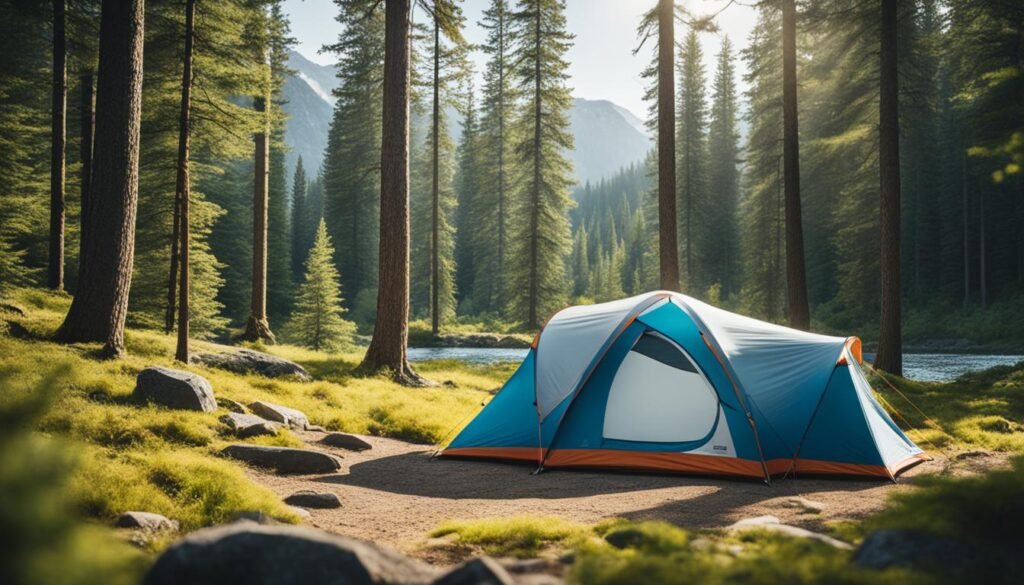
Ultralight Tarps and Shelters
Hyperlite Mountain Gear Flat Tarp
The Hyperlite Mountain Gear Flat Tarp is a top choice for lightweight shelter. It weighs only 11 oz with guy-lines1, making it easy to carry. It’s tough too, thanks to using Dyneema Composite Fabric (DCF) in its build. This tarp is super adaptable, allowing you to set it up in many ways. It’s perfect for anyone who loves the outdoors. Just keep in mind, it won’t keep bugs out alone. You should use a ground cloth with it.
Setup and Configurations
Setting up the Hyperlite Mountain Gear Flat Tarp is flexible. You can choose from different ways to pitch it. The A-frame creates a basic, two-pole shelter. For wind and rain protection, there’s the lean-to. And the pyramid style works well for one-person setups, with a pole or stick in the middle.
Factors to Consider When Choosing a Lightweight Tent
When picking an ultralight tent, weight and size matter a lot. A light shelter means less weight on your back. Try to get tents that are below 3 pounds for solo camping or under 4 pounds for two people.5 Also, think about how small the tent can pack up. This makes it fit better in your backpack.
Weight and Packed Size
Your tent needs to keep you dry in bad weather. Choosing a tent with strong, waterproof materials is key. It should also have good pole design and extra features like entrances and anchor points for stability.6 Remember, single-wall tents might not keep you as dry, but they are still pretty good.
Weather Protection
Don’t just focus on weight and size. The inside space of an ultralight tent matters a whole lot too. Check for two doors, storage areas, and enough room inside. This is important whether you camp alone or with someone.5 The height and how big the tent is affects how comfy you will be.
Livability and Interior Space
Setting Up and Using Lightweight Tents
Pitching Techniques
Setting up an ultralight tent correctly is key to a structurally sound and secure shelter. If you’re using trekking pole tents, it’s essential to adjust the trekking poles to the proper height. After that, attach the tent body to the pole tips. For freestanding tents, secure the tent body to the pre-assembled pole structure. Then, make sure to stake out the corners. Finally, for tarps and shelters, use guy lines and stakes to establish the right shape and tension7.
Ventilation and Condensation Management
Ultralight tents, especially single-wall types, need good ventilation to prevent condensation. To enhance airflow in the tent, use its vents and guy-out points. You can also manage condensation by opening or shutting the tent doors and vestibules wisely. Placing gear or your body directly on the tent walls is a no-go. Also, consider using a ground cloth or footprint to keep the moisture level low7.
Maintenance and Care for Lightweight Tents
Keeping your ultralight tent in good shape is very important.8 After use, lightly wipe both inside and outside with a damp cloth.8 Let it dry completely before storing in a cool, dry place.8 Always put it in a breathable bag to avoid mold.8
Cleaning and Storing
Cleaning your lightweight tent is a vital step.8 Use a soft sponge, cold water, and mild soap to clean by hand.8 Avoid using regular cleaners as they can harm the water-resistant coating.8 Ensure the tent is dry before storing to prevent mildew.8
Repairing and Seam-Sealing
Small fixes and seam-sealing are key for keeping your tent strong.8 Use special tape or patches to mend tears or holes.8 Seal the seams with a liquid sealer to stop water from getting in.8 Also, check the tent often for any damaged parts like zippers or poles. If you find any, replace them promptly.8
By caring for your tent in these ways, it will last through many trips. For more detailed tips, check out The REI expert advice guide on caring for your tent.
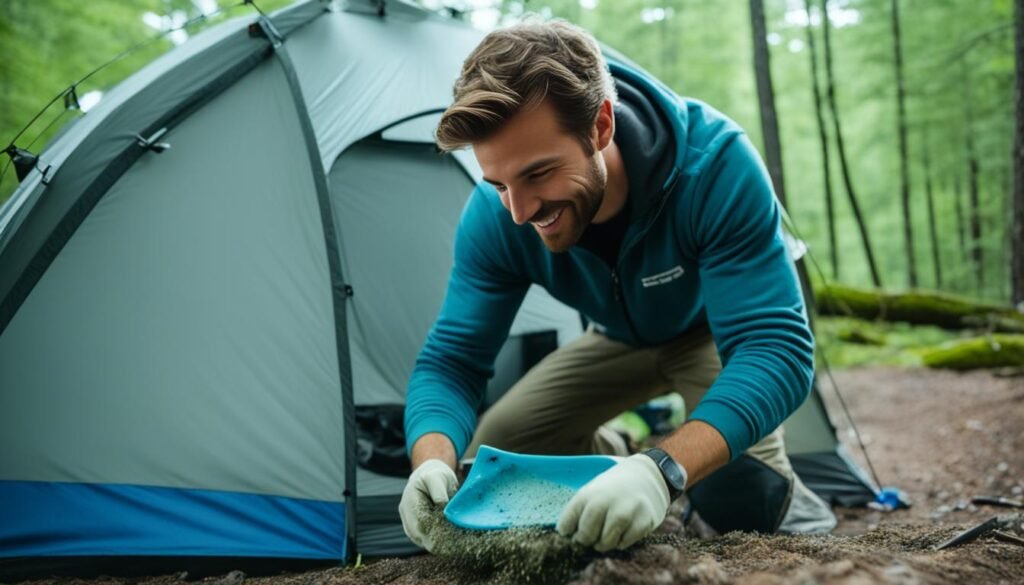
Ultralight Backpacking Gear for Lightweight Camping
Lightweight Backpacks
Lightweight backpacks are key for lightening your load when camping. They should be under 3 pounds and built with simple, tough materials. Comfort is also important, so look for those with adjustable straps. Some good choices are the Zpacks Arc Haul at $224.99, weighing 13.9 oz9, and the Gossamer Gear Kumo or ULA Circuit.
Ultralight Sleep Systems
An ultralight sleep system is the next step in cutting down weight. Use a quilt and a light sleeping pad with your tent. Quilts from Enlightened Equipment are a top pick, priced at $200 and weighing 18.75 oz. Feathered Friends is also well-known for their balance of warmth and weight. For sleeping pads, consider the Therm-a-Rest NeoAir XLite at $219.95, 8.8 oz9, or the Nemo Tensor at $54.95, 14.5 oz9.
Conclusion
Ultralight tents offer many benefits for campers. They’re great for anyone who loves the outdoors. These tents are light, protect from the weather, and are comfy to live in. Choosing the right one makes camping and hiking more fun and less tiring. Options include trekking pole shelters, freestanding styles, and ultralight tarps. The best ultralight tent will change how you enjoy the wild.
Top backpacking tents cost between $100 and $500+10. There are many well-known brands to pick from, like North Face and Big Agnes. No matter your budget, there’s a perfect lightweight tent out there. You can also find great deals at REI Outlet and Backcountry.com Outlet. Backcountry.com offers free shipping on tent orders over $5010.
When looking at ultralight tents, online reviews are a valuable asset10. For a 2-person tent, the best setup is with two poles that make an “X”, with double doors and extra space outside the tent. Good choices are the REI Half Dome and Big Agnes models that fit these features. With the right information, you can choose a tent that improves your time outside.
FAQ
What are the benefits of using lightweight tents?
Lightweight tents are great for backpackers. They make your pack lighter. This means easier travel and more comfort. They’re also good for many outdoor activities.
What are the different types of lightweight tents?
There are several types available. These include trekking pole tents and freestanding ones. You also have single-wall and double-wall options. Plus, ultralight tarps and shelters for different needs.
What are the key features and specifications of the Tarptent StratoSpire Ultra?
The Tarptent StratoSpire Ultra stands out. It has a tough, water-resistant fly fabric. It’s spacious inside with high ceilings. It also includes dual vestibules. Its design is great for handling bad weather.
What are the advantages of the Zpacks Duplex Flex Upgrade?
The Zpacks Duplex Flex Upgrade is super light. It offers a big, cozy space. It’s top-notch in protecting against weather. You can set it up in different ways, using poles or standalone.
What are the key features of the Durston X-Mid 1P Gen 2 and the 3F UL Gear Lanshan 2 Pro?
The Durston X-Mid 1P Gen 2 gives you more room. It’s easy to set up and strong in storms. The 3F UL Gear Lanshan 2 Pro is also spacious for two. It’s simple to set up and has a tough rain fly.
What are the advantages of the Hyperlite Mountain Gear Flat Tarp?
The Hyperlite Mountain Gear Flat Tarp is ultra-light. It uses strong, waterproof fabric. You can set it up in many ways. This offers great flexibility in different places.
What are the key factors to consider when choosing a lightweight tent?
Think about the tent’s weight and size first. Then, consider how well it protects you from the weather. Also, look at its space and comfort inside for what you need.
How do you properly set up and use a lightweight tent?
Setting up right is key. Make sure to adjust poles or use clips properly. Also, managing how air flows in and out is important for comfort and safety.
How do you maintain and care for a lightweight tent?
To keep your tent in good shape, clean it often. Let it fully dry before putting it away. Do small repairs as needed to make it last longer.
What other ultralight gear can complement a lightweight tent?
You can choose lightweight backpacks and sleeping gear. This helps make your camping kit even lighter.
Source Links
- https://www.outdoorgearlab.com/topics/camping-and-hiking/best-ultralight-tent
- https://www.switchbacktravel.com/best-ultralight-tents
- https://www.cleverhiker.com/backpacking/best-ultralight-tarps-and-tents/
- https://westonfront.wordpress.com/2021/01/21/backpacking-tents-a-comprehensive-design-review/
- https://www.livefortheoutdoors.com/camping/advice/how-to-choose-a-backpacking-tent/
- https://www.switchbacktravel.com/how-to-choose-backpacking-tent
- https://backpackinglight.com/forums/topic/58448/
- https://www.rei.com/learn/expert-advice/caring-tent.html
- https://terradrift.com/the-ultimate-ultralight-backpacking-gear-kit/
- https://www.backpacking-guide.com/backpacking-tents-conclusion.html
